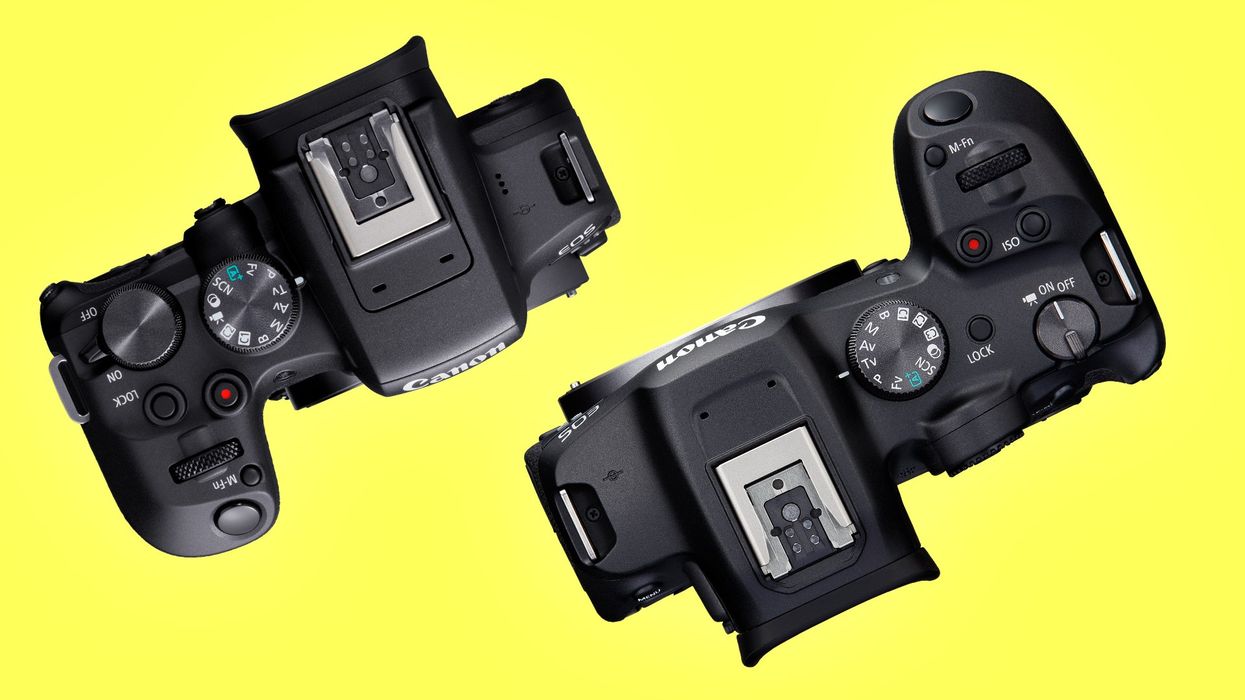Canon Goes Super 35 Mirrorless—Introducing the Canon R7 and R10
Canon R series of cameras have always been full-frame. Now they’re tackling the Super 35-sized APS-C format.

Full-frame cameras have been Canon’s bread and butter. The Canon 5D completely upended the camera world when it offered superb video features for the time.
Remember the hit show House? An entire season finale was shot on the Canon EOS 5D Mark II.
With a full-frame finally cemented in place, Canon has finally set its eyes on the APS-C format. Much like the Canon 7D, the little brother of the 5D, it's time for the R series to get that Super 35 treatment.
Introducing the Canon EOS R7 and EOS R10, the little siblings to the popular Canon R5.

The Canon EOS R7
The first camera of the duo, the Canon EOS R7, feels very much like the successor to the 7D. Although Canon claims the camera is ideal for hobbyists and general photography enthusiasts, if the R7 is anything like its predecessor, it’ll be more than that.
It will feature a 32.5 megapixel APS-C CMOS sensor and will shoot up to 4K 60p in 10-bit 4:2:2. This will crop the sensor a bit, but you can do oversampled 4K at 30p using the full 7K area of the sensor. If that’s still too much resolution, you’ll also be able to go up to 120p in full HD.
Unlike the R10, though, the R7 will be able to shoot in Canon Log 3 for all your cinematic post-production needs.
Canon states a 30-minute recording limit, and the small print does say there could be stoppage due to battery level, card capacity, or internal temperature. Take that as you will, but don’t plan on shooting a two-hour show with this camera.

The R7 will also have 5-axis IBIS with up to 7 stops with coordinated control with compatible lenses and Canon’s Smart Shoe integration for audio accessories such as the Tascam CA-XLR2d.
As for autofocus, the R7 will have the same system as the R10, but will have the same subject recognition modes found in the EOS R3. This will let you prioritize people, animals, or vehicles. The slower readout of the APS-C sensor won’t give you the same performance, but it won’t be a slouch either.
For the photography-minded, the R7 will have continuous shooting at 30fps with the electronic shutter and 15 fps with the mechanical shutter. The cool thing is you’ll get full autofocus with the latter.
Most importantly, all of these features are packed into a body that weighs about 612g.
The Canon EOS R10
The second of the pair is the Canon EOS R10. Even though the number is higher, it’s actually a smaller camera, coming in at 429g.
This camera does away with IBIS and shoots the same 4K 60p and full HD 120p but on a 24.2-megapixel APS-C sensor. It will have the same high-speed shooting 15 fps mechanical shutter and autofocus features, sans the recognition modes. If you end up using the electronic shutter, you’ll only get about 23 fps.
There's not much more to say about the R10 as it's a cheaper alternative with stripped-down features. It doesn't get more introductory than this. That doesn't mean that it's bad. You get robust autofocus, 4K video, and quick continuous shooting that only a decade ago was a flagship feature.

New Lenses
Along with two new cameras, Canon is introducing the RF-S line with two zoom lenses. The 18-45mm F4.5-6.3 IS STM and the 18-150mm F3.5-6.3 IS STM.
At first glance, they seem... fine.
We’re sure they’re sharp and have super-fast autofocus. They’ll take video or photos and give you solid image stabilization, but from a creative (and most importantly narrative) perspective, these won’t be the lenses you’re pulling out of your bag to shoot your scene.
Both lenses are designed for the smaller APS-C sensor and will get the job done. They’re priced at $299.99 for the 18-45mm and $499.99 for the 18-150mm.

So, Which One To Get?
Full-frame has been all the rage, but the Super 35-sized APS-C sensor hasn’t gone away. The recent Blackmagic Cameras have all been in the APS-C format and the upcoming ARRI camera will also be Super 35.
Safe to say, the format isn’t going anywhere.
Canon EOS R10

- 24.2MP APS-C CMOS Sensor
- Dual Pixel CMOS AF II
- 4K60 10-Bit Video, HDR PQ
- 23 fps E. Shutter, 15 fps Mech. Shutter
- 2.36m-Dot OLED EVF
- 1.04m-Dot Vari-Angle Touchscreen LCD
- Multi-Function Shoe, Wi-Fi and Bluetooth
If you squint, both of these new offerings from Canon might look like the same camera. But put on your glasses, and the EOS R7 has a lot more muscle than the R10.
Canon EOS R7

- 32.5MP APS-C CMOS Sensor
- Dual Pixel CMOS AF II
- 4K60 10-Bit Video, HDR-PQ & C-Log 3
- 30 fps E. Shutter, 15 fps Mech. Shutter
- 2.36m-Dot OLED EVF
- 1.6m-Dot Vari-Angle Touchscreen LCD
- Sensor-Shift 5-Axis Image Stabilization
- Dual UHS-II Memory Card Slots
- Multi-Function Shoe, Wi-Fi and Bluetooth
If you’re all into Canon and full-frame is too big for your needs, then these two cameras should definitely be on your shortlist. They come in at $1,499 for the Canon R7 and $979.99 for the Canon R10.
For that price, creatives are getting a solid list of features for an affordable price that aims to compete with Fuji and Panasonic’s offerings. If nothing else, the Canons will be amazing options for filmmakers just learning the ropes.
We’ll have to see how these cameras perform in the wild, but we can confidently say, long live APS-C!
Update, May 24, 7 p.m. PT: The price of the RF-S18-150mm F3.5-6.3 IS STM lens has been corrected to $499.99.
Check out weekly specials, deals, and rebates: Pro Video Gear, Pro Audio Gear, Lighting

 'Anora'Neon
'Anora'Neon Annie Johnson Kevin Scanlon
Annie Johnson Kevin Scanlon









